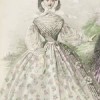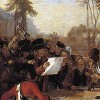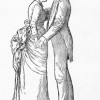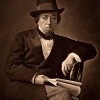
Rebecca N. Mitchell, “15 August 1862: The Rise and Fall of the Cage Crinoline”
First introduced to England by France’s Empress Eugénie in the late 1850s, the cage crinoline signaled a new era in fashion, reaching peak popularity (and peak circumference) in the early 1860s. While the garment has often been understood as a symbol of a repressive patriarchal order intent on confining women, contemporary reporting shows that it was regarded instead as a potentially threatening tool of emancipation. It replaced layers of heavy petticoats with a light and flexible alternative, offering women greater mobility and comfort, and the proportions of the skirts obviated the need for tight-laced corsets. What is more, donning crinoline allowed women to assert physical space in the public sphere, their voluminous skirts forcing men to the margins of the sidewalk or the omnibus—at least according to complaints. Perhaps the most pernicious quality of crinoline, though, was its potential to hide things from the male gaze: bad ankles or smuggled goods might be hidden by the cage, but the risk of concealed pregnancy loomed largest. Reports of death by crinoline fire were matched in their fevered pitch by warnings that crinoline sharply increased rates of infanticide. The range of Victorian responses that accrued around the fashion demonstrates that it was not simply a tool for unilateral oppression or reducible to the manifestation of empty, thoughtless vanity.

Thomas McLean, “Donation and Collaboration: Joanna Baillie’s A Collection of Poems, Chiefly Manuscript, and From Living Authors, April 1823″
The Scottish poet and playwright Joanna Baillie spent most of 1822 soliciting unpublished or uncollected works from literary acquaintances, including Anna Barbauld, William Wordsworth, and Sir Walter Scott, for a new volume of verse. The purpose of the volume, which appeared in April 1823 as A Collection of Poems, Chiefly Manuscript, and from Living Authors, was to raise funds for a family in financial distress. Relying on Baillie’s letters and new archival research, this essay tells the fuller story of Baillie’s Collection and considers it as an innovative act of literary philanthropy, a precursor to the British annual, and a significant gathering of one strand of Romantic-era poetry. An amended table of contents identifies some of the anonymous and lesser-known contributors.

Frederick Burwick, “18 June 1815: The Battle of Waterloo and the Literary Response”
Although Europe had celebrated the end of the Napoleonic Wars with the defeat of the French armies and the abdication of the emperor on 11 April 1814, Napoleon escaped and again rallied his troops against the British and Prussian armies. His defeat at Waterloo on 18 June 1815 was the final battle with heavy losses on all sides. The extensive response in the British press was unprecedented. In addition to several military reports of the battle, many civilian eye-witness narratives also appeared. Memoirs, histories, and biographies added to the prose accounts. With contributions from Lord Byron, Sir Walter Scott, Robert Southey, William Wordsworth, and many minor authors, the poetry included both celebrations of the victory and lamentations over the loss of lives. Theatres, too, brought forth numerous spectacles and melodrama. Londoners were also treated to several exhibitions and panorama displaying scenes from the battle (Favret 8-12).

Cheryl A. Wilson, “The Arrival of the Waltz in England, 1812”
The arrival of the waltz in England changed both the experience of participating in the ballroom and the cultural impact of Victorian social dance.

Siobhan Carroll, “On Erasmus Darwin’s The Botanic Garden, 1791-1792″
1792 witnessed the publication of the complete version of Erasmus Darwin’s The Botanic Garden, a lengthy nature poem that surveyed the state of science in its day. The Botanic Garden proved immensely popular on its publication but later fell out of favor as the Anti-Jacobin took aim at its liberal politics. This paper focuses on one of the most notorious sections of the poem, in which Darwin describes his plan to change the world’s climate via iceberg destruction. The argument traces the reception of Darwin’s climate imagery from its initial reception through its redeployment in the poetry of Percy Bysshe Shelley. Although The Botanic Garden and its plan for climate intervention might be framed in terms of what philosophers call the “negative event”—an event that fails to happen—Darwin was essentially correct in his assertion that the technologies of the industrial revolution could be used to change the climate of the globe.

Erika Rappaport, “Object Lessons and Colonial Histories: Inventing the Jubilee of Indian Tea”
The fifty-year Jubilee of Indian tea was celebrated in the Spring and Summer of 1887, coinciding precisely with Queen Victoria’s Golden Jubilee. This Jubilee had nothing to do with Victoria per se, but rather the commercial anniversary invented Indian/Ceylon tea as an icon of imperial Britishness. Industry leaders used 1887 to highlight specifically two key events in tea’s commercial and imperial history, the first moment tea arrived in Britain from Assam (1837) and the first time (April 1887) that tea from both India and Ceylon surpassed imports from China. They explained the later development by arguing that Britons had learned to appreciate modern industrial production and plantation agriculture more than old-fashioned and dirty Chinese modes of production. The Jubilee thus marked publicly how and when tea became a mass-produced and consumed imperial product.

Terry F. Robinson, “National Theatre in Transition: The London Patent Theatre Fires of 1808-1809 and the Old Price Riots”
The years 1808-1809 mark a major period of transition in English National Theatre. In the space of just a few months, London’s two patent playhouses—the Theatres Royal Covent Garden and Drury Lane—burned to the ground. The devastation was total and complete. This article tells the story of the two theatre fires and explores their economic, political, and cultural repercussions, direct and indirect, including the reconstruction of Covent Garden and Drury Lane, the Old Price Riots, and the career dénouements of Richard Brinsley Sheridan, John Philip Kemble, Sarah Siddons, and Dorothy Jordan. In the process of providing a historical and graphic overview, it proposes that the London Theatre fires of 1808-1809 not only created significant professional and financial turmoil but also helped to engender a shift from an eighteenth-century to a nineteenth-century theatrical paradigm.

Heidi Kaufman, “1800-1900: Inside and Outside the Nineteenth-Century East End”
This essay examines depictions of one of the infamously well-known region of London called “The East End.” Scholarly and popular discussions of this part of the city have been dominated by texts emphasizing the East End’s seedy or sensational social and economic features. In particular, popular writing has focused on the history of poverty, crime, and resident “alien” or immigrant groups living in the East End. While such stereotypes were often loud in their sensationalism, and while they often overpowered competing narratives, this essay makes the case for reading them alongside a range of narratives about the East End, many of which were produced by residents of this part of London. In what follows, I consider a mix of insider and outsider lenses, of well-known and lesser-known voices that produced a varied range of depictions of the nineteenth-century East End. In the process, I argue that the East End ought not to be characterized as simply a site of crime and poverty. To understand this important part of London, we must instead examine a fuller range of voices emerging from disparate, often competing, perspectives. Through this mix, we can begin to register the East End’s economic, cultural and social diversity witnessed and described in discordant ways by visitors and residents alike.

Robert O’Kell, “On Young England”
Young England was a short-lived social and political movement that developed from the altruistic ideas of a small parliamentary ginger group within the Conservative Party in the 1840s. At the core of the movement were Benjamin Disraeli (their acknowledged leader), Lord John Manners, George Sydney Smythe and Alexander Baillie Cochrane, all of whom were appalled at the state of party politics, class conflict, and the economic and moral condition of Victorian England’s poor. Their dissatisfaction with Sir Robert Peel’s leadership of the Party gained popular momentum when, between 1844 and 1847, Disraeli published a trilogy of novels that embodied both devastating satirical attacks on traditional Tory politics and an idealistic, nostalgic vision of a revitalized aristocracy motivated by social duty.

Marjorie Stone, “The ‘Advent’ of Aurora Leigh: Critical Myths and Periodical Debates”
Released by Chapman and Hall on 15 November 1856, Elizabeth Barrett Browning’s Aurora Leigh—a verse-novel and modern epic—set off literary, social, and political reverberations in Britain, North America, and Europe up to the end of the century. “The advent of ‘Aurora Leigh’ can never be forgotten by any lover of poetry who was old enough at the time to read it,” Algernon Charles Swinburne recalled in 1898. By 1900, Aurora Leigh—among much else the first extended poetical portrait of the professional woman writer in English literature—had appeared in more than twenty editions in England and as many in America. Given its innovative, generically mixed form and its controversial contemporary subject matter, it figured in debates over poetry and poetics, the nature of the realist novel, class divisions and social reform, women’s rights, religion, and the politics of nations. Contrary to the critical legend that Aurora Leigh was greeted by an “avalanche of negative reviews,” responses to it were diverse, shaped by periodical competition and differing print-culture, artistic, political, national and religious contexts. This essay surveys seldom-cited notices in the transatlantic daily and weekly press, analyzes critical debates on Aurora Leigh in the major British periodicals, and charts differing patterns in its American and European as compared to its British reception in the years immediately following its publication. It also indicates at points how debates over Aurora Leigh were intertwined with debates in the visual arts associated with the paintings of J. M. W. Turner and the Pre-Raphaelites.
